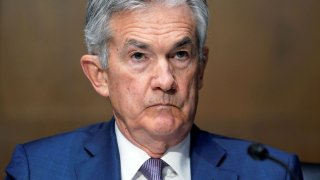
- The Federal Reserve meets Tuesday and Wednesday amid worries over the impact the rise in coronavirus cases will have on the economy.
- While its options are getting more limited, the Fed has several weapons its can still deploy.
- Markets will be watching for Fed movement on its bond purchases.
- Specifically, the central bank could decide to lengthen the maturities of the bonds, expand the total purchases, and list what outcomes it wants to achieve before curtailing the program.
The Federal Reserve heads into its meeting next week in a familiar place, with a teetering economy that could be in further danger unless Congress approves more dollars to support those still getting slammed by the coronavirus pandemic.
Also familiar ground: The Fed has limited policy options to help boost activity and is left now with some language tinkering on what it would take to raise interest rates in the future, and what it can do to help things along through its asset purchase program.
Markets, then, will be left to watch for policy nuance and nudges rather than the kind of bold steps it has seen the central bank take previously.
On the menu will be expanding the $120 billion in bonds a month through quantitative easing, adjusting the maturity of those purchases, or providing "outcomes-based" guidelines it will need to see before tightening policy from its current historically loose level.
Interest rate cuts are not part of that policy buffet, as the Fed's benchmark rate is already anchored near zero.
Money Report
"They have to get incrementally more dovish next week," said Brian Nick, chief investment strategist with Nuveen's Global Investment Committee, using a term to describe looser policy. "I think they're going to go with the maturity extension of the QE program, that's the first step you would take. Increasing the size of QE might send a little more alarming signal than they would like to take at this moment."
Going out on the duration curve would enhance the focus of the latest QE leg from its initial purpose of keeping markets functioning to lowering longer-term interest rates. From the Fed's view, that decreases borrowing cost for consumers and spurs moves into risk assets, both of which are focused at broader economic growth rather than just keeping liquidity moving.
An outright expansion of borrowing, with the Fed's asset holdings at nearly $7.3 trillion, might, as Nick indicated, signal an even more troubled economy, an alarm the Fed may not want to sound. Most of the Fed's holdings are Treasurys and mortgage-backed securities that are the targets of the current purchases.
Fed officials will lose some of their other tools when special lending powers they were granted during the pandemic run out. That leaves them with limited options for what could be some difficult days ahead, particularly if no fiscal package from Congress is forthcoming.
"I'm not sure they're ready to do something, to introduce some fresh monetary stimulus. I think they will hope that it puts more pressure on the fiscal side," said Tom Graff, head of fixed income at Brown Advisory. "They're really hoping that this spate of rough jobs numbers gets Congress in gear to help out and they don't have to do anything more" at the Fed.
November's nonfarm payrolls number was below expectations, and jobless claims last week rose to their highest level since September.
'Most important' thing to do
In addition to adjusting the duration, the Fed also will talk about adoption the "outcome-based language" that would tie any unwinding of current accommodation to specific goals. The Fed already has an inclusive full employment mandate that entails allowing inflation to run above the 2% target for a period of time.
Still, adding further guidelines would be "the most important innovation" the Fed can adopt for now, wrote Matthew Luzzetti, chief U.S. economist at Deutsche Bank.
He anticipates that the post-meeting statement from the policymaking Federal Open Market Committee will include language that the current bond purchases and near zero interest rates will stay in place until "substantial progress" is made towards the inflation/employment mandate.
"In this way, the FOMC can clarify to market participants that asset purchases will cease sometime prior to lift-off, while providing a rough indication of the time horizon over which they envision conducting asset purchases via their SEP forecasts," Luzzetti said in a note.
"While expectations for tapering in the future are no doubt a key input into the Committee's forward guidance discussions, we anticipate that Powell will avoid any signal of contemplating removing monetary accommodation any time soon," he added.
To be sure, there is considerable uncertainty in the market over whether the Fed will in fact make any significant changes at the Tuesday-Wednesday meeting, or wait until 2021.
Members at the November session did indicate a willingness to adopt the outcome-based approach. But Dallas Fed President Robert Kaplan recently told CNBC that he is content with policy where it is and doesn't see the need for changes.
The Fed might be better off waiting until the January meeting, which will happen after the Jan. 5 Georgia Senate elections that will determine the balance of the power in the upper chamber, said Quincy Krosby, chief market strategist at Prudential Financial.
"Wouldn't it be prudent of them to wait until Jan. 5 to see what happens with the number of Covid cases, with what happens with the election to see if Democrats take control? Why go off now and offer anything concrete when you can do it after the election?" Krosby said. "The patience in the market is going to have to continue."
Indeed, the FOMC meeting comes at a volatile time, with the crosscurrents of surging virus cases happening along with the first implementation of vaccines. Expectations are that while 2021 will be a rough start for the economy, the presence of the vaccine should help growth accelerate strongly through the latter part of the year.
"Monetary policy is running smoothly at this time and we don't see any reason to alter the policy setting or give additional guidance about what they might do in the future," wrote Chris Rupkey, chief economist at MUFG Union Bank. "Fed policy depends on the economy and the economy depends on the course of the virus."






